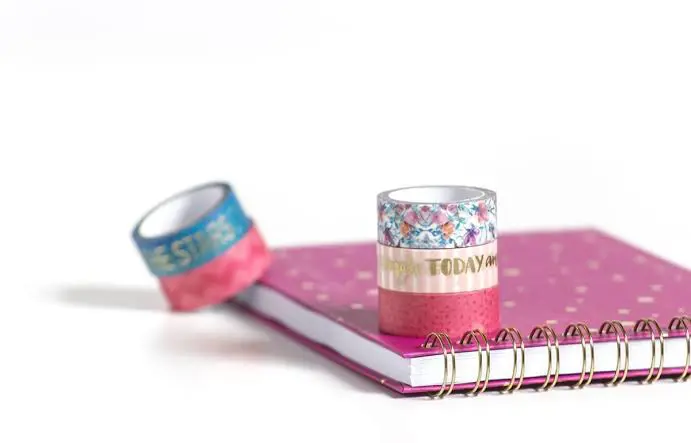Last Updated on October 27, 2023 by Umer Malik
Washi tape is a versatile and fun way to decorate or personalize your home. It’s a Japanese adhesive paper product that comes in many colors, patterns, and sizes. Washi tape is made from paper that has been coated with an acrylic adhesive. The process consists of printing images on sheets of paper, coating them with an adhesive, and then cutting them into strips. Washi tape is a versatile and inexpensive tool that can be used to decorate almost anything. They are also easy to customize with your own designs, colors, and patterns. Washi tape is made from a thin layer of cloth or paper that is coated in a resin. The process of custom washi tape printing creating the tape was invented by a Japanese designer named Katsuko Saruhashi in 1958. It’s then coated with paint or ink for decoration. The paint or ink is transferred onto the cloth by pressure, heat, or through the use of an adhesive. There are many different ways to use washi tape to make your own designs or decorate objects you already have. Here are some ideas:
– Use it as a wrapping for gifts
– Use it to add color and pattern to plain surfaces
– Decorate old furniture
– Add some personality to your school projects
– Make crafts for kids
– Printing on Washi Tape using stencils
– Printing on Washi Tape using screen printing technology
Table of Contents
What is custom washi tape printing?
Custom washi tape printing is a process of printing paper on a roll of washi tape. The process involves using ink and a stencil to print text, images, or patterns onto the paper. The process is usually used for decorating party invitations, gift wrapping, and other small items. The process is done by hand but it can be done with an automated machine as well. Washi tape is a Japanese craft product that is used primarily as a decorative adhesive tape. It is typically made of paper or cloth, but can also be made from other materials such as fabric and plastic. Washi tape has been used in many different types of art, including origami, calligraphy, stenciling and painting. Founded in Japan, washi tape is a thin, paper-based adhesive tape with a fabric-like surface. The material comes in a variety of colors and can be used for many different crafts and decorating projects. It’s easy to use, durable and inexpensive.
How does custom washi tape printing Work?
Washi tape is a type of Japanese adhesive tape made from paper. It is usually found in rolls, but can also be cut into smaller pieces. The adhesive on the tape is typically a type of acrylic, although it can also be made out of vinyl or polyester. Washi Tape has many uses, such as decorating items for sale at craft markets and events, wrapping gifts, and protecting furniture from scratches. The substrate position refers to the position on the surface where the adhesive will be applied to. When you are applying washi tape to an item that has a rough surface like wood or metal, you will want to apply it with an angle so that it adheres better. Washi tape printing is a process of applying a washi tape to a surface. It is usually used for decoration and art projects. Washi tape printing is an ancient Japanese craft that has been around for over 1,000 years. With the advent of digital printing, the popularity of washi tape has grown in recent decades.
There are many different techniques to use when putting up a project using washi tapes including:
– Printing on paper with a laser printer
– Printing on fabric
– Printing on glass or ceramic tiles
– Printing on walls or floors
5 Ways to customize your washi tape print
With the help of these 5 ways, you can customize your washi tape print to make it a more personal and unique statement. Washi tape is an easy way to spruce up your decor and add some personality to your walls. It’s also a cheap and easy way to give a room a quick update. But sometimes, it can be difficult to find just the right design for that one wall. If you’re looking for more ways to customize your washi tape print, here are five ways that might help:
-Foil stamp:
Add foil or glittery foil stamps onto your washi tape print using an ink pad or permanent marker.
-Add images:
You can use an ink pad or permanent marker on the back of prints without any images before you put them on walls
-Create glittery prints:
You can use glitter glue or sequins with your washi tapes before adding them onto walls -Make special designs: If you’re feeling creative, you could add washi tape designs onto the wall
-Make a D.I.Y. art wall:
You can use washi tape to create a mosaic
this idea is perfect for beginners and people who are new to making art
Why use custom printed washi tapes?
The best thing about using washi tapes is that they are customizable and can be used in a variety of ways. They also have a huge price difference to regular paper which is why they are perfect for DIY projects. Washi tape has been around for centuries and it has been used in Japan as an art form since the 17th century. It started to gain popularity in the Western world during the 1980s when it was used as a decorative item or for wrapping gifts. Washi tape is a type of paper-based adhesive strips that are usually made from rice paper, cloth, or synthetic materials such as polyester or vinyl acetate. It’s often sold with multiple designs on one roll of tape, which can be torn off and reused again and again without damaging the design on the roll.
What are the different types of washi tapes?
There are many different types of washi tapes. They can be made from paper, cloth, or plastic. There are also various patterns that you can create with washi tape. Washi tapes are a type of adhesive tape that is used for wrapping gifts and decorating surfaces. In Japan, the word ‘washi’ means ‘to wrap’. It is generally used to make origami and other craft projects. The most common materials for custom washi tape printing are paper and cloth but there are also plastic types as well. The most popular pattern on washi tapes is the checkered pattern which looks like a traditional Japanese flag.
Apart from this, if you are interested to know about Inspiring Healthy Lifestyles then visit our Lifestyle category.

























